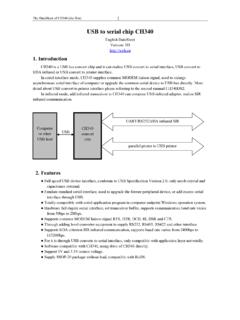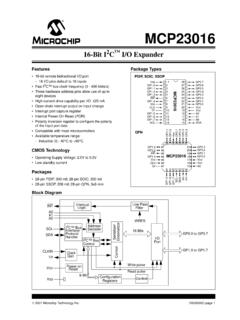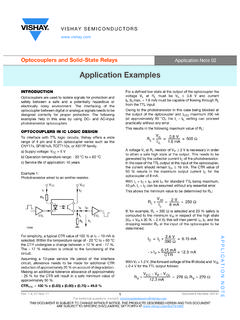Transcription of 8-bit Microcontroller with 8K Bytes In-System Programmable ...
1 Features Compatible with MCS -51 Products 8K Bytes of In-System Programmable (ISP) Flash Memory Endurance: 10,000 Write/Erase Cycles to Operating Range Fully Static Operation: 0 Hz to 33 MHz Three-level Program Memory Lock 256 x 8-bit Internal RAM 32 Programmable I/O Lines Three 16-bit Timer/Counters Eight Interrupt Sources Full Duplex UART Serial Channel Low-power Idle and Power-down Modes Interrupt Recovery from Power-down Mode Watchdog Timer Dual Data Pointer Power-off Flag Fast Programming Time Flexible ISP Programming (Byte and Page Mode) Green (Pb/Halide-free) Packaging Option1. DescriptionThe AT89S52 is a low-power, high-performance CMOS 8-bit Microcontroller with 8K Bytes of In-System Programmable Flash memory.
2 The device is manufactured using Atmel s high-density nonvolatile memory technology and is compatible with the indus-try-standard 80C51 instruction set and pinout. The on-chip Flash allows the program memory to be reprogrammed In-System or by a conventional nonvolatile memory pro-grammer. By combining a versatile 8-bit CPU with In-System Programmable Flash on a monolithic chip, the Atmel AT89S52 is a powerful Microcontroller which provides a highly-flexible and cost-effective solution to many embedded control AT89S52 provides the following standard features: 8K Bytes of Flash, 256 Bytes of RAM, 32 I/O lines, Watchdog timer, two data pointers, three 16-bit timer/counters, a six-vector two-level interrupt architecture, a full duplex serial port, on-chip oscillator, and clock circuitry.
3 In addition, the AT89S52 is designed with static logic for operation down to zero frequency and supports two software selectable power saving modes. The Idle Mode stops the CPU while allowing the RAM, timer/counters, serial port, and interrupt system to continue functioning. The Power-down mode saves the RAM con-tents but freezes the oscillator, disabling all other chip functions until the next interrupt or hardware Microcontroller with 8K Bytes In-System Programmable FlashAT 8 9 S 5 2 1919D MICRO 6/08 21919D MICRO 6/08AT89S52 2. Pin TQFP123456789101112131415161718192040393 83736353433323130292827262524232221(T2) (T2 EX) (MOSI) (MISO) (SCK) (RXD) (TXD) (INT0) (INT1) (T0) (T1) (WR) (RD) (AD0) (AD1) (AD2) (AD3) (AD4) (AD5) (AD6) (AD7)EA/ (A15) (A14) (A13) (A12) (A11) (A10) (A9) (A8)123456789101133323130292827262524234 4434241403938373635341213141516171819202 122(MOSI) (MISO) (SCK) (RXD) (TXD) (INT0) (INT1) (T0) (T1) (AD4) (AD5) (AD6) (AD7)EA/ (A15) (A14) (A13) (T2 EX) (T2) (AD0) (AD1) (AD2) (AD3)(WR) (RD) (A8) (A9) (A10) (A11) (A12) PLCC789101112131415161739383736353433323 13029(MOSI) (MISO) (SCK)
4 (RXD) (TXD) (INT0) (INT1) (T0) (T1) (AD4) (AD5) (AD6) (AD7)EA/ (A15) (A14) (A13)65432144434241401819202122232425262 728(WR) (RD) (A8) (A9) (A10) (A11) (A12) (T2 EX) (T2) (AD0) (AD1) (AD2) (AD3) 31919D MICRO 6/08 AT89S523. Block DiagramPORT 2 DRIVERSPORT - 0 LATCHRAMPROGRAMADDRESSREGISTERBUFFERPCIN CREMENTERPROGRAMCOUNTERDUAL DPTRINSTRUCTIONREGISTERBREGISTERINTERRUP T, SERIAL PORT,AND TIMER BLOCKSSTACKPOINTERACCTMP2 TMP1 ALUPSWTIMINGANDCONTROLPORT 1 - 3 LATCHPORT 3 - / VPPRSTRAM 0 - 1 LATCHWATCHDOGISPPORTPROGRAMLOGIC 41919D MICRO 6/08AT89S52 4. Pin 0 Port 0 is an 8-bit open drain bidirectional I/O port.
5 As an output port, each pin can sink eight TTL inputs. When 1s are written to port 0 pins, the pins can be used as high-impedance inputs. Port 0 can also be configured to be the multiplexed low-order address/data bus during accesses to external program and data memory. In this mode, P0 has internal 0 also receives the code Bytes during Flash programming and outputs the code Bytes dur-ing program verification. External pull-ups are required during program verification. 1 Port 1 is an 8-bit bidirectional I/O port with internal pull-ups. The Port 1 output buffers can sink/source four TTL inputs. When 1s are written to Port 1 pins, they are pulled high by the inter-nal pull-ups and can be used as inputs.
6 As inputs, Port 1 pins that are externally being pulled low will source current (IIL) because of the internal pull-ups. In addition, and can be configured to be the timer/counter 2 external count input ( ) and the timer/counter 2 trigger input ( ), respectively, as shown in the follow-ing 1 also receives the low-order address Bytes during Flash programming and 2 Port 2 is an 8-bit bidirectional I/O port with internal pull-ups. The Port 2 output buffers can sink/source four TTL inputs. When 1s are written to Port 2 pins, they are pulled high by the inter-nal pull-ups and can be used as inputs. As inputs, Port 2 pins that are externally being pulled low will source current (IIL) because of the internal 2 emits the high-order address byte during fetches from external program memory and dur-ing accesses to external data memory that use 16-bit addresses (MOVX @ DPTR).
7 In this application, Port 2 uses strong internal pull-ups when emitting 1s. During accesses to external data memory that use 8-bit addresses (MOVX @ RI), Port 2 emits the contents of the P2 Special Function 2 also receives the high-order address bits and some control signals during Flash program-ming and PinAlternate (external count input to Timer/Counter 2), (Timer/Counter 2 capture/reload trigger and direction control) (used for In-System Programming) (used for In-System Programming) (used for In-System Programming) 51919D MICRO 6/08 3 Port 3 is an 8-bit bidirectional I/O port with internal pull-ups. The Port 3 output buffers can sink/source four TTL inputs.
8 When 1s are written to Port 3 pins, they are pulled high by the inter-nal pull-ups and can be used as inputs. As inputs, Port 3 pins that are externally being pulled low will source current (IIL) because of the 3 receives some control signals for Flash programming and 3 also serves the functions of various special features of the AT89S52, as shown in the fol-lowing table. input. A high on this pin for two machine cycles while the oscillator is running resets the device. This pin drives high for 98 oscillator periods after the Watchdog times out. The DISRTO bit in SFR AUXR (address 8EH) can be used to disable this feature. In the default state of bit DISRTO, the RESET HIGH out feature is Latch Enable (ALE) is an output pulse for latching the low byte of the address during accesses to external memory.
9 This pin is also the program pulse input (PROG) during Flash programming. In normal operation, ALE is emitted at a constant rate of 1/6 the oscillator frequency and may be used for external timing or clocking purposes. Note, however, that one ALE pulse is skipped dur-ing each access to external data memory. If desired, ALE operation can be disabled by setting bit 0 of SFR location 8EH. With the bit set, ALE is active only during a MOVX or MOVC instruction. Otherwise, the pin is weakly pulled high. Setting the ALE-disable bit has no effect if the Microcontroller is in external execution PinAlternate (serial input port) (serial output port) (external interrupt 0) (external interrupt 1) (timer 0 external input) (timer 1 external input) (external data memory write strobe) (external data memory read strobe) 61919D MICRO 6/08AT89S52 Store Enable (PSEN) is the read strobe to external program memory.
10 When the AT89S52 is executing code from external program memory, PSEN is activated twice each machine cycle, except that two PSEN activations are skipped during each access to exter-nal data memory. EA/VPPE xternal Access Enable. EA must be strapped to GND in order to enable the device to fetch code from external program memory locations starting at 0000H up to FFFFH. Note, however, that if lock bit 1 is programmed, EA will be internally latched on reset. EA should be strapped to VCC for internal program pin also receives the 12-volt programming enable voltage (VPP) during Flash XTAL1 Input to the inverting oscillator amplifier and input to the internal clock operating XTAL2 Output from the inverting oscillator Special Function RegistersA map of the on-chip memory area called the Special Function Register (SFR) space is shown in Table that not all of the addresses are occupied, and unoccupied addresses may not be imple-mented on the chip.















